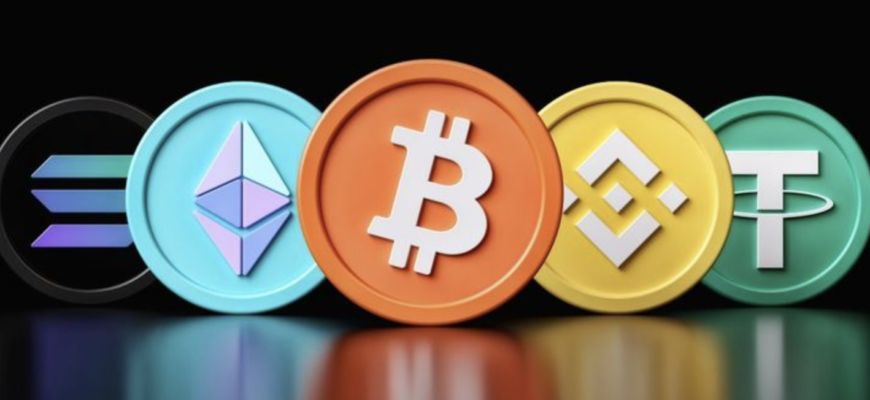The digital asset market continues to evolve, offering new opportunities for both experienced investors and those who are planning to invest. Against the backdrop of growing interest and expanding infrastructure, there is a need to understand which coins truly deserve attention.
The best cryptocurrencies for investment in 2025 are not just popular names, but assets with proven technologies, high liquidity, and growing demand. Their selection is based not on rumors, but on market analysis, capitalization, functionality, and growth prospects.

Why is crypto so popular among investors?
Among the key factors of attractiveness of digital assets are:
- high volatility, allowing to profit from price fluctuations;
- decentralization, reducing the influence of government regulators;
- blockchain technology foundation, providing transparency and security;
- ease of access to trading through exchanges and wallets;
- portfolio diversification beyond traditional assets.
These advantages explain why cryptocurrencies are so popular in 2025 among both individuals and institutional players.
Key parameters for evaluating the best cryptocurrencies for investments
To determine which coins will make it to the top, investors consider:
- daily trading volume and liquidity level;
- market capitalization and growth dynamics;
- unique technological features;
- developer activity and community support;
- real-world use beyond speculation.
Not all assets are suitable for long-term holding. Only the best cryptocurrencies for investments meet the criteria of stability and potential growth in the long term.
Bitcoin (BTC)
Bitcoin is the first and most recognizable digital currency. Its limited supply, high capitalization, and status as “digital gold” make it the foundation of any crypto portfolio.
Despite decreasing volatility, it maintains stable demand, remaining a reliable asset during market instability. Among all positions included in the best cryptocurrencies for investments, Bitcoin holds the leading position.
Ethereum (ETH)
Ethereum introduced the concept of smart contracts and created a whole ecosystem of decentralized applications.
Network upgrades, transition to Proof-of-Stake, and high developer activity ensure sustainable growth. ETH continues to be among the top cryptocurrencies, remaining attractive for long-term investment and active trading.
Tether (USDT)
USDT is a stablecoin pegged to the US dollar. It is used as a protective asset during periods of high volatility.
High trading volume and versatility make it an indispensable part of a strategy. Among the tools included in the best cryptocurrencies for investments, Tether serves as a stable anchor.
Solana (SOL)
Solana offers fast transaction processing, low fees, and scalability. These parameters have led to active usage in projects related to NFTs, DeFi, and the gaming industry.
Recovery after technical failures and an increase in the number of developers confirm its potential. Among promising cryptocurrencies besides Bitcoin, Solana holds a special place due to its technological foundation.
USD Coin (USDC)
USDC, like Tether, is considered a stablecoin pegged to the dollar but stands out for its increased transparency. It is widely used in institutional settlements and DeFi platforms.
Regulatory oversight and a reliable issuance system allow its use for capital protection. Thanks to its advantages, it confidently enters the list of the best cryptocurrencies for investments.
XRP (XRP)
XRP was created as a means for instant cross-border transfers. Its speed, scalability, and low fees allow its use in international settlements.
Despite regulatory risks, the asset maintains its position due to partnerships with banks and financial institutions. XRP is in demand in the market, and its inclusion in popular digital currencies confirms its stability.
Cardano (ADA)
Cardano develops a scientific approach to blockchain solutions. Its architecture is based on research and phased implementation of updates.
The platform focuses on security, scalability, and eco-friendliness. Participation in educational and social projects strengthens its foundation.
Among all those shaping the best cryptocurrencies for investments, ADA stands out for its technological conservatism.
Dogecoin (DOGE)
Dogecoin started as a joke but thanks to the community and support from public figures, it has become a real payment instrument.
Its high volatility makes it interesting for short-term trading. Despite its meme origins, it ranks among the top due to sustained interest and popularity in the retail segment.
Avalanche (AVAX)
Avalanche offers a unique consensus mechanism and high transaction processing speed. The network actively develops, supporting the creation of applications, games, and DeFi services.
Fast confirmation time, scalability, and interest from institutional investors make AVAX a reliable portfolio foundation. It is among the promising cryptocurrencies besides Bitcoin and consistently maintains its position.
Toncoin (TON)
Toncoin, based on Telegram developments, attracts attention with its architecture and integration with the messenger.
In 2025, Toncoin is actively used for micropayments and corporate solutions. Among those considered the best cryptocurrencies for investments, TON demonstrates rapid popularity growth and technological ambition.
Factors influencing the price and demand for crypto
There are many parameters that affect the price. To navigate the market, it is important to track:
- overall market conditions and cycle phases;
- news background, including legislative initiatives;
- network updates and technical hard forks;
- partnerships with major players;
- fiat market dynamics and inflation expectations.
Each of these factors influences demand. Only in-depth analysis allows for the formation of a list that includes the best cryptocurrencies for investments considering long-term potential.

Best cryptocurrencies for investments: the key
The digital asset market offers a wide choice. However, not every coin is worthy of investment. The best cryptocurrencies for investments in 2025 are a combination of reliability, liquidity, and technological stability.
It is important for an investor not to chase hype but to build a strategy based on analysis, balance, and understanding of goals. Only then does crypto become a tool, not a game of chance!
 en
en  de
de  ar
ar  es
es  hi
hi  fr
fr  nl
nl  it
it  pt
pt  el
el 



